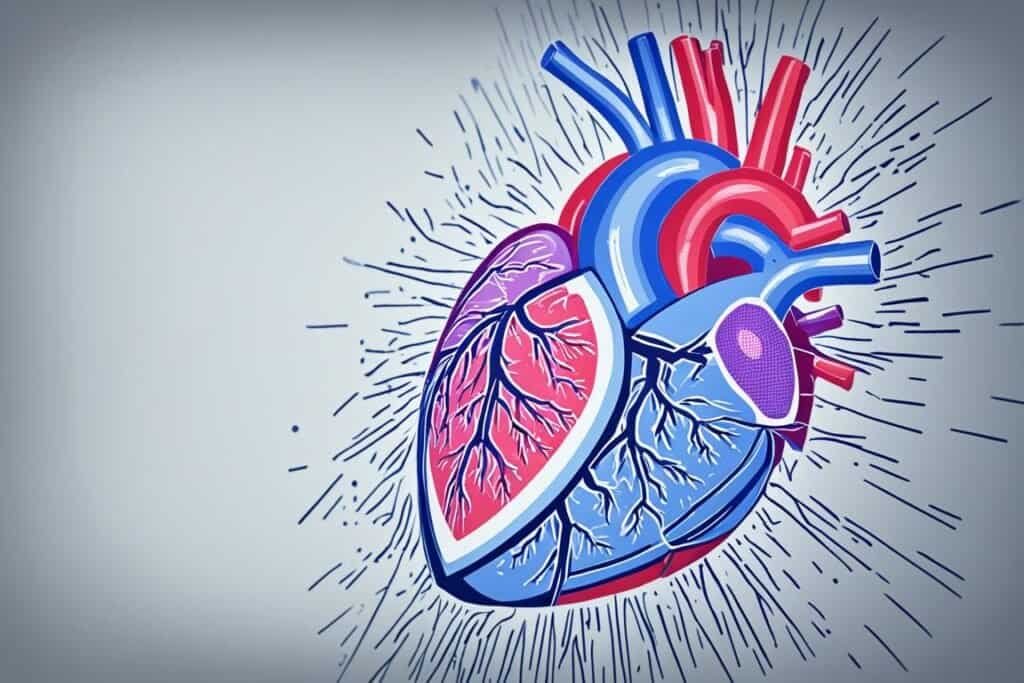Having a healthy heart is vital for overall well-being, and one important factor in determining heart health is resting heart rate. This refers to the number of times your heart beats per minute while at rest. Lower resting heart rate is often associated with better heart health and reduced risk of heart attacks.
Several factors can influence your resting heart rate, including age, fitness level, health conditions, medications, body size, and even environmental factors like emotions, temperature, and humidity. It is important to understand the impact of your resting heart rate on heart health and the potential risk of heart attacks.
Key Takeaways:
- A lower resting heart rate is generally considered better for heart health.
- Factors like age, fitness level, health conditions, medications, and environmental factors can influence resting heart rate.
- Having a higher resting heart rate may increase the risk of heart attacks and cardiovascular diseases.
- Monitoring your resting heart rate and seeking medical advice are important for maintaining heart health and reducing the risk of heart attacks.
- Leading a healthy lifestyle, including regular exercise and a balanced diet, can help improve heart health and lower resting heart rate.
The Relationship Between Resting Heart Rate and Heart Attack
A person’s resting heart rate can serve as an indicator of their risk for a heart attack. Studies have found that individuals with a higher resting heart rate may have an increased risk of experiencing a heart attack. The resting heart rate is the number of times the heart beats per minute while at rest, and it reflects how efficiently the heart is pumping blood. A lower resting heart rate indicates that the heart is working more efficiently and can be beneficial for cardiovascular health. Conversely, a higher resting heart rate may suggest that the heart is under more stress, increasing the risk of heart disease and heart attack.
Monitoring resting heart rate is an essential aspect of cardiovascular health management. It provides valuable insights into the efficiency and health of the heart. A lower resting heart rate is associated with better cardiovascular health, while a higher resting heart rate can indicate underlying issues and increased risk of heart attack.
How a Heart Attack Affects Heart Rate
During a heart attack, the heart’s electrical system can be significantly impacted, leading to changes in heart rate. This section will discuss how heart rate is affected during a heart attack and the potential implications for individuals experiencing this cardiac event.
A heart attack can cause the heart rate to undergo both accelerated and decelerated changes, depending on the specific circumstances and factors involved.
Firstly, a heart attack may result in a slowing down of the heart rate, particularly if the right coronary artery is affected. This can occur due to the interruption of blood flow to certain areas of the heart, impeding the electrical signals that regulate heart rate and causing a temporary decrease in heart rate.
On the other hand, a heart attack can also cause the heart rate to remain elevated, specifically in cases of tachycardia, where the heart beats abnormally fast. This can be a result of the body’s response to the cardiac event, as it tries to compensate for the decreased oxygen supply to the heart by increasing heart rate.
Monitoring heart rate during a heart attack is crucial as it provides valuable information about the severity of the condition and the potential risks involved. By closely monitoring heart rate changes, medical professionals can assess the impact of the heart attack on the individual’s cardiovascular system and determine the appropriate treatment and interventions.

Effects of Heart Attack on Heart Rate
| Heart Attack Type | Heart Rate Changes |
|---|---|
| Right Coronary Artery Involvement | Decreased heart rate |
| Tachycardia | Increased heart rate |
Different Types of Heart Attacks and Their Effects on Heart Rate
Heart attacks can occur in different forms, each with its own impact on heart rate. Understanding these variations can help you recognize the signs and symptoms of a heart attack and seek prompt medical attention. Here are the different types of heart attacks and their effects on heart rate:
STEMI Heart Attacks
A ST-elevation myocardial infarction (STEMI) heart attack occurs when a coronary artery is completely blocked by a blood clot. This type of heart attack often results in an increase in heart rate, especially if the front part of the heart is affected. The body’s natural response to the blocked artery is to increase heart rate to compensate for the reduced blood flow. This increased heart rate helps deliver more oxygen and nutrients to the heart muscle, but it also signifies the severity of the blockage and the urgency of medical intervention.
NSTEMI Heart Attacks
A non-ST elevation myocardial infarction (NSTEMI) heart attack involves partial blockages of the coronary arteries. Similar to STEMI heart attacks, NSTEMI heart attacks can also cause changes in heart rate. The extent of heart rate change during NSTEMI heart attacks varies depending on factors such as the location and severity of the blockage. In some cases, heart rate may increase as the body tries to compensate for the reduced blood flow. However, heart rate changes during NSTEMI heart attacks may be less pronounced compared to STEMI heart attacks.
Coronary Spasms
Coronary spasms occur when the coronary arteries constrict, impeding blood flow to the heart. This condition can lead to either tachycardia (abnormally fast heart rate) or minimal changes in heart rate. The increase in heart rate during coronary spasms is the body’s natural response to increase oxygen supply to the heart. On the other hand, some individuals may experience little change in heart rate due to the restricted blood flow. Monitoring heart rate during coronary spasms is crucial in assessing the severity of the condition and enabling appropriate treatment.
Understanding the effects of different types of heart attacks on heart rate can help you recognize the signs and symptoms of a heart attack. If you experience any chest pain, discomfort, shortness of breath, or other symptoms related to heart health, seek immediate medical attention to prevent further complications.
Medications and Medical Conditions that Affect Heart Rate During a Heart Attack
Certain medications and medical conditions can have a significant impact on heart rate during a heart attack. Understanding how these factors influence heart rate can provide crucial insights into managing and treating a heart attack effectively.
Effect of Medications on Heart Rate During a Heart Attack
During a heart attack, specific medications can play a vital role in influencing heart rate. Beta-blockers, for example, are medications that slow down the heart rate. They work by blocking the effects of adrenaline, which can help manage the heart’s workload and keep the heart rate low even during a heart attack. Nitrates, antiplatelet agents, anticoagulants, and calcium channel blockers are other medications that can impact heart rate during a heart attack in different ways.
| Medication | Effect on Heart Rate During a Heart Attack |
|---|---|
| Beta-blockers | Slow down heart rate, keeping it low |
| Nitrates | May cause a slight decrease in heart rate |
| Antiplatelet agents | No direct impact on heart rate |
| Anticoagulants | No direct impact on heart rate |
| Calcium channel blockers | May cause a slight decrease in heart rate |
Table: Medications and their effects on heart rate during a heart attack.
Effect of Medical Conditions on Heart Rate During a Heart Attack
Alongside medications, pre-existing medical conditions can also influence heart rate during a heart attack. Two common medical conditions that can impact heart rate are tachycardia and bradycardia.
Tachycardia is a condition characterized by an abnormally fast heart rate. During a heart attack, tachycardia can cause the heart rate to remain high, putting the heart under additional stress.
On the other hand, bradycardia is a condition in which the heart rate is slower than normal. It can result in a slower heart rate during a heart attack, reducing the heart’s ability to pump blood effectively.
Monitoring heart rate during a heart attack is essential, considering the influence of both medications and medical conditions. By understanding these factors, healthcare professionals can make informed decisions to provide the most appropriate care and management for patients.

The Impact of Heart Attack on Blood Pressure
A heart attack can have significant effects on blood pressure. When a heart attack occurs, the damage to the heart muscle can weaken its pumping action. This weakened pumping action can potentially lead to a decrease in blood pressure. The heart’s ability to efficiently circulate blood throughout the body is compromised, resulting in a drop in blood pressure.
Additionally, during a heart attack, the body’s parasympathetic nervous system may be activated. This activation causes relaxation while the heart struggles to maintain blood circulation. As a result, blood pressure can further decrease.
It is important to note that blood pressure changes during a heart attack can vary from person to person. Some individuals may experience a significant drop in blood pressure, while others may not see as pronounced of a decrease. Monitoring and managing blood pressure during and after a heart attack are crucial for appropriate treatment and care.
To ensure optimal recovery and minimize the risk of complications, it is essential to work closely with healthcare professionals. They will be able to provide specific guidance on managing blood pressure, as well as recommend lifestyle changes and medication, if necessary.
Regular monitoring of blood pressure levels, maintaining a healthy lifestyle, and following prescribed treatment plans can help minimize the impact of a heart attack on blood pressure. By taking proactive steps, you can support your heart’s healing process and improve overall cardiovascular health.
Conclusion
Recognizing the symptoms of a heart attack is crucial for early intervention and treatment. Common symptoms include chest pain or discomfort, pain in the arms, chest, back, neck, and jaw, cold sweat, shortness of breath, nausea, and lightheadedness. These symptoms should never be ignored and require immediate medical attention.
Understanding the risk factors for a heart attack is also important. Factors such as high blood pressure, high cholesterol, smoking, advancing age, obesity, diabetes, a family history of heart disease, and a personal history of heart disease or stroke can significantly increase the risk. It is essential to be aware of these risk factors and take proactive steps to manage and reduce them.
Monitoring your resting heart rate is one way to assess your heart health. A lower resting heart rate is generally considered better, indicating a more efficient heart function. Maintaining a healthy lifestyle, including regular exercise, a balanced diet, managing stress levels, and avoiding smoking and excessive alcohol consumption, can help reduce the risk of a heart attack. It is also crucial to seek medical advice and undergo regular check-ups to monitor your heart health and address any potential concerns. Remember, your heart health is in your hands. Take care of it today for a healthier tomorrow.

